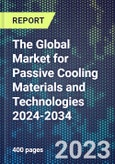Passive Cooling Unleashes Sustainable Solutions in Key Markets
Passive cooling utilizes heat dissipation methods without external energy input, relying on conduction, convection and radiation processes. Major markets include building cooling, cold chain logistics, electronics cooling, textiles and personal comfort. Demand is driven by needs for energy efficiency, temperature controlled transport, and thermal management.
The Global Market for Passive Cooling Materials and Technologies 2024-2034 provides a comprehensive analysis of the global passive cooling materials and technologies landscape. It covers key principles like conduction, convection, and radiation that enable passive cooling as well as materials like phase change materials, graphene, carbon nanotubes, aerogels, hydrogels, and metamaterials.
Detailed ten-year market forecasts are segmented by end-use industry, material type, and region provide insights into revenue opportunities. Profiles of over 200 leading companies developing and supplying passive cooling solutions are included along with analyses of product portfolios, partnerships, and R&D priorities.
The report highlights high-potential applications in buildings, electronics, electric vehicles, apparel, cold chain, and energy storage. Comparisons of competing material technologies for thermal management are presented. Current commercial products are benchmarked and technical readiness of emerging solutions is assessed.
Report contents include:
- Executive summary covering market overview, drivers, emerging materials, electrification impacts, and applications roadmap
- Materials and technologies analysis of:
- Thermal interface materials
- Phase change materials
- Carbon materials like graphene, nanotubes, nanodiamonds
- Aerogels
- Hydrogels
- Metamaterials
- Heat pipes
- Radiative cooling
- Cooling paints and coatings
- Ten-year market forecasts segmented by:
- End use industry
- Material type
- Region
- Profiles of over 200 leading companies developing and supplying passive cooling solutions. Companies profiled include AOS Thermal Compounds, Aspen Aerogels, BioLife Solutions, Inc., Boyd Corproation, Cabot Corporation, Dow Corning, Enerdyne Solutions, Enersens, Fujipoly, Guangdong Alison Hi-Tech, Henkel, HyMet Thermal Interfaces SIA, i-TES, Momentive and Radi-Cool.
- Analysis of passive cooling applications in buildings, electronics, electric vehicles, apparel, cold chain, and energy storage
- Benchmarking of commercial products and assessment of technical readiness of emerging solutions
- Comparisons of competing material technologies for thermal management
This product will be delivered within 1-3 business days.
Table of Contents
1 Research Methodology
Companies Mentioned (Partial List)
A selection of companies mentioned in this report includes, but is not limited to:
- AOS Thermal Compounds
- Aspen Aerogels
- BioLife Solutions Inc.
- Boyd Corporation
- Cabot Corporation
- Dow Corning
- Enerdyne Solutions
- Enersens
- Fujipoly
- Guangdong Alison Hi-Tech
- Henkel
- HyMet Thermal Interfaces SIA
- i-TES
- Momentive
- Radi-Cool








